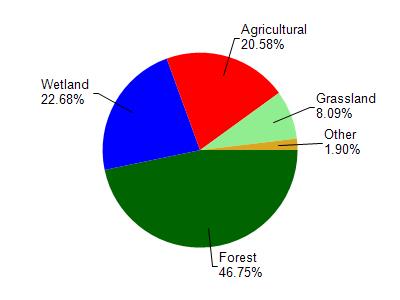Portage
No
No
No
Fish and Aquatic Life
Overview
Lions Lake, in the Upper Little Wolf River Watershed, is a 44.51 acre lake that falls in Portage County. This lake is managed for fishing and swimming and is currently not considered impaired.
Date 2011
Author Aquatic Biologist
Historical Description
Source: 1972, Surface Water Resources of Portage County
Lions Lake, T25N, R10E, Section 16, Surface Acres-38.6, S.D.F.-
1.59, Maximum Depth-10 feet
Of all the variety of lakes in Portage County, or Wisconsin
as a whole, Lions Lake is one of the most unique. Formerly known
as Kiolbassa Lake, the name was changed to recognize the Wisconsin
Lions Foundation's camp for the visually handicapped. The Lions
Foundation owns all the land around the lake. Because of the
unique nature of the camp, this is the only lake in Wisconsin that
has a law protecting it from any public access purchase as long as
the camp remains in operation. In addition, the Department of
Natural Resources helps maintain a fishery for the benefit of
campers even though no public access is present or will be
obtained. Presently, the camp is in the process of being expanded
to include the deaf and retarded. All campers, including husbands
and wives of campers, stay at the camp free. The only developments
on the lake belong to the camp. These consist of thirteen cabins,
four campsites, a cafeteria, and a caretaker's residence. More
cabins are planned. A nice sand beach with many safety devices and
lifeguard is present. Other camping activities include boating,
fishing, hiking, hayrides, sports, and tent camping. All Lions
Club lands are in a game refuge, and wildlife is fed during the
winter. Deer, muskrats, and beaver are present. The lake is a
hard water spring lake with a navigable outlet, Bradley Creek. A
small dam maintains the lake level six to eight inches above
normal. Marl is the predominant bottom type and sand and silt are
also present. The lake has a history of at least partial
winterkills during hard winters. As a result, an undesirable
bullhead population had taken over the lake prior to 1963. In
1963, the DNR chemically treated the lake to remove the fish
population. Today the lake is managed for northern pike and perch.
Largemouth bass, pumpkinseed, and bullheads are also present. Camp
personnel, visiting Lions, and guests of campers may fish for sport
using barbless hooks, releasing all fish caught. Only campers may
keep the fish they catch.
Date 1972
Author Surface Water Inventory Of Wisconsin
Condition
Wisconsin has over 84,000 miles of streams, 15,000 lakes and milllions of acres of wetlands. Assessing the condition of this vast amount of water is challenging. The state's water monitoring program uses a media-based, cross-program approach to analyze water condition. An updated monitoring strategy (2015-2020) is now available. Compliance with Clean Water Act fishable, swimmable standards are located in the Executive Summary of Water Condition in 2018. See also the 'monitoring and projects' tab.
Reports
Management Goals
Wisconsin's Water Quality Standards provide qualitative and quantitative goals for waters that are protective of Fishable, Swimmable conditions [Learn more]. Waters that do not meet water quality standards are considered impaired and restoration actions are planned and carried out until the water is once again fishable and swimmable
Management goals can include creation or implementation of a Total Maximum Daily Load analysis, a Nine Key Element Plan, or other restoration work, education and outreach and more. If specific recommendations exist for this water, they will be displayed below online.
Monitoring
Monitoring the condition of a river, stream, or lake includes gathering physical, chemical, biological, and habitat data. Comprehensive studies often gather all these parameters in great detail, while lighter assessment events will involve sampling physical, chemical and biological data such as macroinvertebrates. Aquatic macroinvertebrates and fish communities integrate watershed or catchment condition, providing great insight into overall ecosystem health. Chemical and habitat parameters tell researchers more about human induced problems including contaminated runoff, point source dischargers, or habitat issues that foster or limit the potential of aquatic communities to thrive in a given area. Wisconsin's Water Monitoring Strategy was recenty updated.
Grants and Management Projects
Monitoring Projects
| WBIC | Official Waterbody Name | Station ID | Station Name | Earliest Fieldwork Date | Latest Fieldwork Date | View Station | View Data |
|---|
| 288800 | Lions Lake | 10005132 | Lions Lake | 7/27/1999 | 9/30/2017 | Map | Data |
| 288800 | Lions Lake | 503172 | Lions Lake - Lions Lake | | | Map | Data |
| 288800 | Lions Lake | 504005 | Lions Lake - Center | 8/7/1979 | 5/29/2015 | Map | Data |
|

Watershed Characteristics
Lions Lake is located in the Upper Little Wolf River watershed which is 182.05 mi². Land use in the watershed is primarily forest (46.80%), wetland (22.70%) and a mix of agricultural (20.60%) and other uses (10.00%). This watershed has 160.69 stream miles, 841.95 lake acres and 26,786.17 wetland acres.
Nonpoint Source Characteristics
This watershed is ranked Medium for runoff impacts on streams, Not Ranked for runoff impacts on lakes and High for runoff impacts on groundwater and therefore has an overall rank of High. This value can be used in ranking the watershed or individual waterbodies for grant funding under state and county programs.However, all waters are affected by diffuse pollutant sources regardless of initial water quality. Applications for specific runoff projects under state or county grant programs may be pursued. For more information, go to surface water program grants.